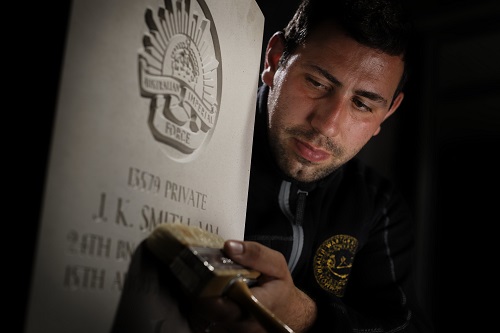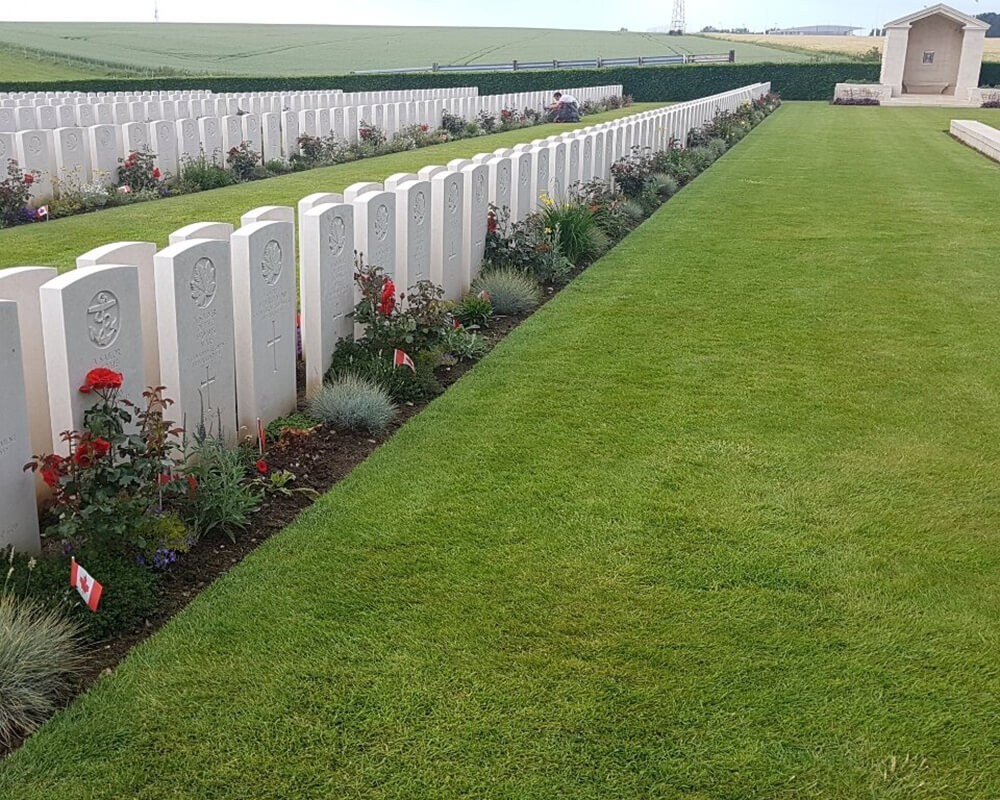The CWGC Visitor Centre - Commonwealth War Graves in France
GO BEHIND THE SCENES WITH A GLOBAL LEADER IN COMMEMORATION
The CWGC Visitor Centre lets you go behind the scenes of the remarkable work we undertake to maintain British and Commonwealth cemeteries and memorials around the world.
Located in Beaurains, France, in the heart of the former Western Front, our Visitor Centre spotlights our highly skilled craftsmen, carpenters, stonemasons, mechanics, and blacksmiths. Their tireless efforts ensure our sites globally are kept to the high standards and beautiful aesthetics associated with CWGC sites.
This is your chance to see the inner workings of one of the world’s foremost commemoration organisations.
Our free audio tour is an in-depth guide to every aspect of our work: from how we still recover and rebury the dead of the World Wars, to our highly skilled craftsmen’s vital role in maintaining and caring for the most impressive and recognisable war cemeteries and memorials worldwide.
Legacy of Champions

For the duration of the Olympics, we are running a special exhibition on those Olympians who fought and fell in the World Wars. Discover the stories of the soldiers, sailors, and airmen who reached the peak of sporting excellence but made the ultimate sacrifice in person. Their greatest challenge is not being forgotten. If you're planning a trip to France this summer, make a stop at our visitor centre in Beaurains.



Visiting Information
Opening times and facilities
We're open from Monday to Friday, 9 am to 4 pm from March to November.
The CWGC Visitor Centre is closed at weekends and on French public holidays. From the beginning of December to the end of February, the Centre will only be open for groups on bookings.
Please note that the centre will also be closed for public holidays from 29 March to 1st April, 1st, 8, 20 May, 12 July, 15 August, 1st November.
Facilities
Toilets, a gift shop and vending machines are available at the centre.
Accessibility
The CWGC Visitor Centre is open to all and we strive to ensure that all of our visitors can enjoy as much of our centre as possible.
If you have any questions or want to know how we can support your visit please contact us at visitcwgc@cwgc.org or call us on +33 (0)3 21 21 52 75.
Assistance dogs are welcome.
Parking
Entry to the CWGC Visitor Centre is free and free parking is provided for all vehicles with fewer than 12 seats.
We have limited parking for larger vehicles and 12-seaters and above must book in advance of their visit.
A parking fee applies to larger vehicles.
Are you planning to visit as part of a group? All coach bookings must be made in advance of your visit.
Find The CWGC Visitor Centre
Location information
The CWGC Visitor Centre is located just south of Arras, in the Hauts de France region, the heart of the First World War battlefields. The centre is only an hour from the channel ports and is easily reached by car (public parking is available on site). There are good rail links to Arras. Our address is:
The Commonwealth War Graves Commission
5-7 rue Angele Richard
62217 Beaurains
France
You can get to us:
By car
From Lille or Paris: direct access from the A1 motorway (exit 15) onto the D939.
From Calais: take the A26 to Saint-Quentin. Exit 7 to Arras-Centre onto the D917.
By train
Eurostar from London to Lille with good connections from Lille to Arras. TGV from Paris to Arras.
By ferry/channel tunnel
Ferry services to Calais, Le Shuttle service to Calais.
By air
Lille airport in Lesquin or Charles de Gaulle airport, Paris.
Explore nearby - Arras France map

Located in the heart of the battlefields of the First World War, The CWGC Visitor Centre is an easy drive away from some of the most recognisable French war graves and locations on the Western Front.
Download our map and visit some of the key cemeteries and war memorials in France or war graves in Arras.
Situated between two war cemeteries, Cabaret-Rouge British Cemetery lies south of Souchez, France.
Find out moreIt commemorates over 72,000 men of British and South African forces who died in the Somme sector.
Find out moreAbout the war graves around Arras, France
How many war graves are there in France?
There are more than 700,000 commonwealth casualties of the two world wars commemorated on our war memorials and in our cemeteries across France.
Many of the burials are in our large CWGC cemeteries like Etaples Military Cemetery, Bayeux War Cemetery and Cabaret-Rouge British Cemetery, but a large number are buried in groups of ones and twos in local churchyards and burial grounds near to where they died.
How many British war graves are in France?
There are more than 475,000 British casualties of the two world wars commemorated by the Commonwealth War Graves Commission at cemeteries and memorials in France. More than 440,000 of these casualties lost their lives during the First World War, while the remaining 35,000 died during the Second World War.
Which are the best war graves to visit in France?
The Commonwealth War Graves Commission, formerly the Imperial War Graves Commission, has been caring for the fallen in France since its formation during World War One.
Today we have cemeteries and memorials across France, commemorating the men and women of the Commonwealth who died on French soil during both world wars.
War graves France WW1
From the border with Belgium down to the border with Switzerland, the trenches of the Western Front cut a bloody path through France. You can find war graves at our cemeteries along the front lines. Here are some you might be interested to visit:

FAUBOURG D'AMIENS CEMETERY
Faubourg D’Amiens Cemetery is found in the town of Arras, in the Pas de Calais department of France, close to the CWGC Visitor Centre in Beaurains.
It was formed in March 1916 adjacent to a large French military cemetery, and was used throughout the war. The cemetery was further extended after the war as casualties were brought from smaller burial sites in the region.
The cemetery contains more than 2,650 burials of World War One as well as the Arras Memorial, which commemorates nearly 35,000 Commonwealth casualties who have no known grave, and the Arras Flying Services Memorial, which commemorates nearly 1000 airmen of the First World War who were lost in the skies over the Western Front.

ETAPLES MILITARY CEMETERY
Designed by Sir Edwin Lutyens, Etaples Military Cemetery is the largest CWGC cemetery in France, with nearly 12,000 burials.
Etaples was home to the principle staging post and transport depot, due to its position on the coast and proximity to the important ports of Calais and Boulogne, as well as vital rail links with the front lines. Due to its position away from the fighting, It was home to as many as eleven hospitals during the war.
The casualties buried here were either evacuated from the front lines for medical care and later died of their wounds, died in transit or were brought to the cemetery after the war from other burial sites. 119 Second World War burials can also be found here.

VIS-EN-ARTOIS BRITISH CEMETERY
Vis-en-Artois sits on the main road between Arras and Cambrai, and was occupied by the German forces from September 1914 until its liberation in August 1918.
Vis-en-Artois, and nearby Haucort, were taken by the Allied forces during the Battle of the Scarpe, part of the Hundred Days offensive which paved the way to the end of the war in Europe.
The cemetery itself was formed immediately after the capture of the region, and was used until the middle of October, with nearly 300 Canadian burials and 55 British burials there. Following the end of the war, the cemetery was enlarged and used for the burials of nearly 2,400 World War One soldiers from other sites, including men from The United Kingdom, Canada, Australia, South Africa and Germany. Nearly 1,500 of the burials here remain unidentified.
War graves France WW2
War returned to France with the German invasion of 1940, and was the site of some of the most well known battles of the war. Discover more about finding war graves from World War Two.

BAYEUX WAR CEMETERY
One of the most famous World War Two battles in France was Operation Overlord - the invasion of Normandy.
On 6 June 1944, a combined Allied force launched the largest naval invasion ever seen against five Normandy beaches: Gold, Sword, Omaha, Utah and Juno. While the invasion was a success, the fighting on the beaches and the push into the calvados countryside cost thousands of lives on both sides.
The first French town to be liberated following the invasion was the historic town of Bayeux, which became the site of the Bayeux War Cemetery, where more than 4,000 Commonwealth war dead are buried, as well as about 500 war graves of other nations, the majority German.
The cemetery is home to the Bayeux Memorial, which bears the names of 1,800 men of the Commonwealth land forces who died during the invasion and in the early days of the campaign and who have no known grave.

DUNKIRK TOWN CEMETERY
Another of the most well known actions of World War Two in France was the evacuation of Dunkirk.
Following the declaration of war in 1939, the British Expeditionary Force was sent to help defend France and Belgium from an expected German invasion. The invasion came in May 1940, and the German Blitzkrieg - lightning war - overwhelmed the defenders, pushing them back to the French coast.
Against such a formidable attack, the British, Belgian and French armies were pushed back to the French coast, and the decision was made to evacuate as many men as possible to avoid their capture or destruction. The port of Dunkirk, in the Hauts-de-France region of France was chosen for the evacuation.
The combined efforts of the Royal Navy and the famed ‘little ships’ to evacuate the soldiers, the efforts of the RAF to prevent German bombing raids, and multiple rear-guard actions to delay the advancing Germans, meant that nearly 340,000 Allied troops were evacuated from the European mainland.
Dunkirk Town Cemetery is the final resting place of nearly 800 World War Two war casualties, of which more than 200 are unidentified. The cemetery is also home to the Dunkirk Memorial which commemorates more than 4,500 Commonwealth war dead who died in France in 1939 and 1940 and who have no known grave.

DIEPPE CANADIAN WAR CEMETERY
Operation Jubilee, the raid on Dieppe by a predominantly Canadian Allied Force, was one of the most costly operations of the Second World War.
Although a naval landing on the French coast, Operation Jubilee was not a full invasion. Instead, its objectives were to capture the port of Dieppe, destroy important military targets in the area, gather vital intelligence at the same time, and then to depart.
Instead, the invading force found well prepared defences, and more than half were killed, captured, wounded or missing by the time the raiding forces withdrew. The heavy losses taught the Allies valuable lessons that would later influence the planning and eventual success of the invasion of Normandy.
Nearly 1000 of those who died during Operation Jubilee are today buried at Dieppe Canadian War Cemetery, the vast majority of whom are Canadian.






